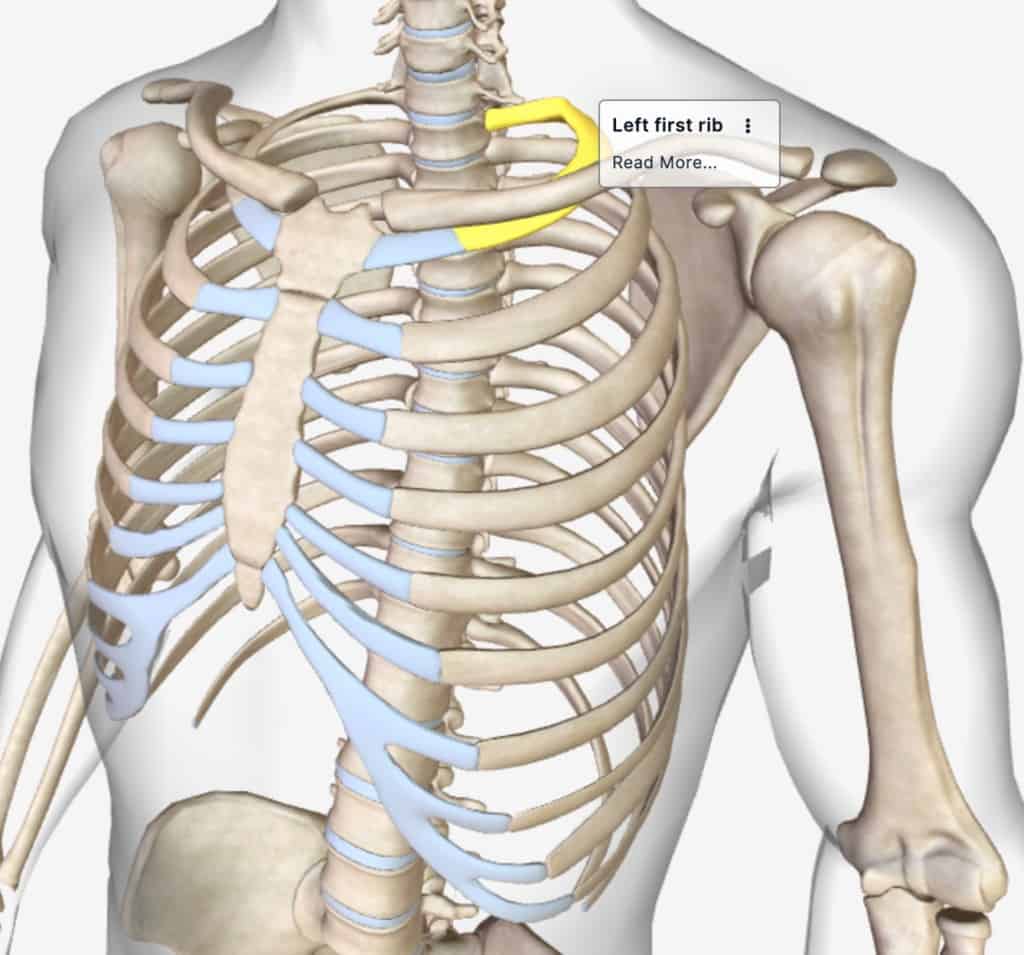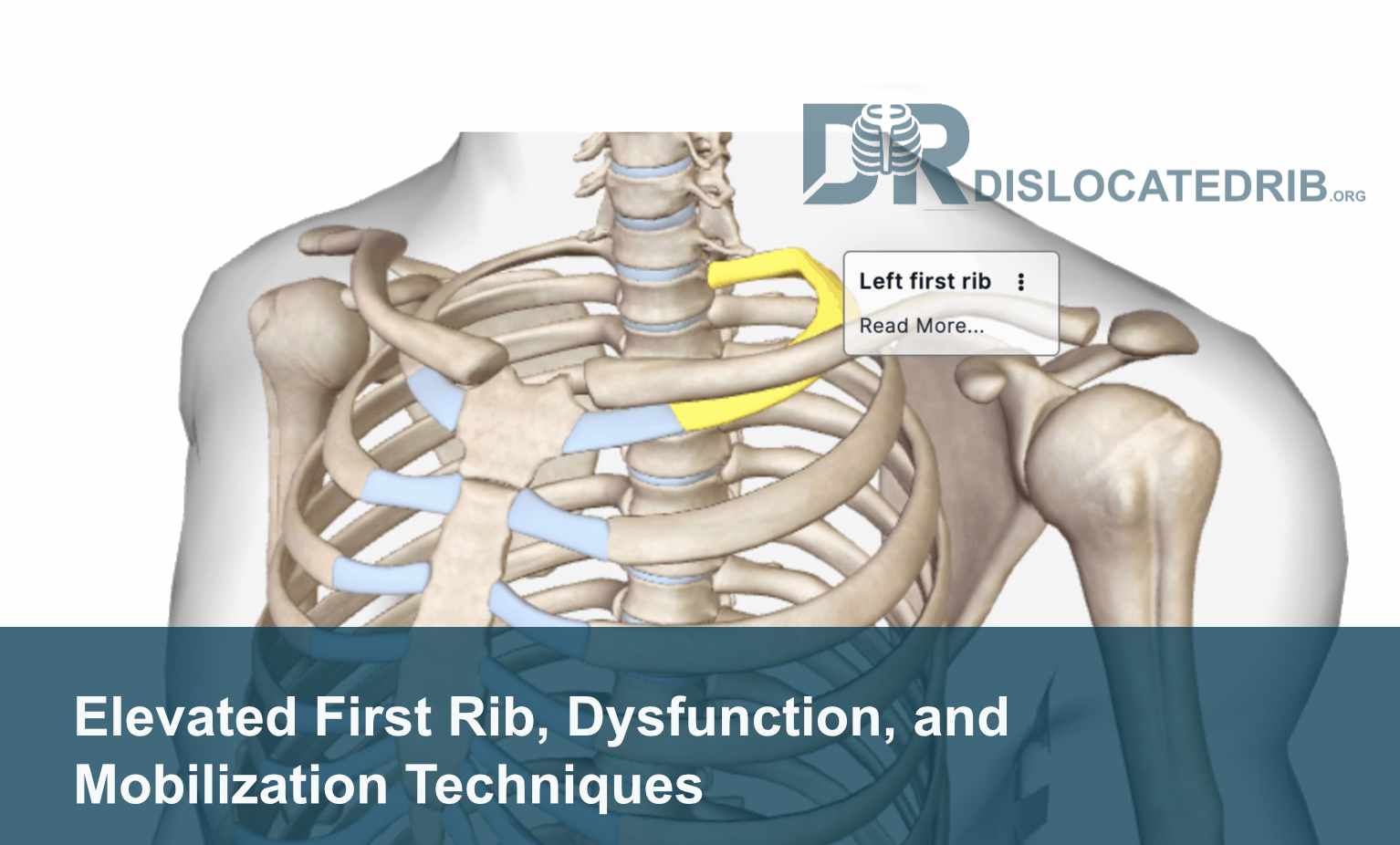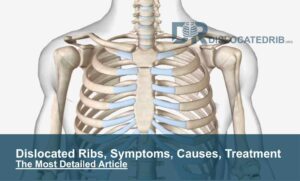An elevated first rib might not be a term familiar to everyone, yet its impact on those affected can be profound and far-reaching. This condition, where the first rib rises above its normal position, can lead to a cascade of symptoms and discomfort, affecting an individual’s ability to perform daily activities and significantly diminishing their quality of life. Understanding what an elevated first rib is, recognizing the symptoms it can cause, and knowing the treatment options available are crucial steps toward managing and overcoming this condition.
The first rib plays a pivotal role in the musculoskeletal and respiratory systems, serving as an anchor for muscles of the neck and upper chest while protecting vital arteries, veins, and nerves passing through the thoracic outlet to the upper limbs. Its elevation, therefore, can compress these vital structures, leading to a complex of symptoms known as thoracic outlet syndrome, among other potential issues. The causes of an elevated first rib can vary, ranging from traumatic injury and repetitive strain to anatomical anomalies.
For those experiencing this condition, the journey to recovery begins with an accurate diagnosis, which often involves specific tests and an understanding of the unique symptoms associated with the elevation of the first rib. From discomfort during daily activities to challenges finding a comfortable sleeping position, the symptoms of an elevated first rib can permeate every aspect of life. However, with appropriate treatment—ranging from physical therapy and manual adjustments to lifestyle modifications—relief is achievable.
This article aims to shed more light on elevated first ribs, exploring the anatomy, causes, symptoms, diagnosis, and treatment options whether you’re a healthcare professional, someone experiencing symptoms, or simply curious about this condition.
Anatomy and First Rib
To fully grasp the implications of an elevated first rib, it’s essential to start with a foundational understanding of its anatomy and role within the body. The first rib is the uppermost rib in the human rib cage, and due to its unique structure and position, it plays several critical roles in the musculoskeletal and respiratory systems.
The Unique Structure of the First Rib
- Position and Structure: The first rib is shorter, broader, and more curved than the other ribs. It’s located at the top of the rib cage, directly beneath the clavicle (collarbone).
- Articulation Points: It connects to the spine at the first thoracic vertebra and, unlike the other ribs, has only one facet for articulation with the spine, making its stability and position crucial for its function.
- Muscular Attachments: Several important muscles attach to the first rib, including the scalene muscles, which play a significant role in the elevation of the rib during breathing.
Role in the Musculoskeletal and Respiratory Systems
- Respiratory Function: The first rib serves as a stable base for the expansion of the upper chest during deep inhalation. Its elevation is part of the normal breathing process, but when it remains abnormally elevated, it can disrupt normal respiratory mechanics.
- Protection of Vital Structures: The first rib forms part of the thoracic outlet, through which vital nerves (brachial plexus) and blood vessels (subclavian artery and vein) pass from the neck to the arm. An elevated first rib can compress these structures, leading to a range of symptoms.
Understanding Elevated First Rib
- What It Means: An elevated first rib refers to a condition where the rib remains in a higher-than-normal position, which can lead to compression of the neurovascular bundle passing through the thoracic outlet.
- Implications: The elevation can cause not only physical discomfort but also interfere with nerve conduction and blood flow, potentially leading to thoracic outlet syndrome, characterized bynumbness, and weakness and of course, pain in the upper limbs.
In summary, the first rib occupies a critical juncture in the body, supporting respiratory function, facilitating upper limb movement, and protecting vital pathways. An elevated first rib disrupts this delicate balance, underscoring the need for a thorough understanding of its potential impact on health and well-being.

Causes and Symptoms of Elevated First Rib
An elevated first rib doesn’t occur without reason; various factors can lead to its abnormal positioning, each with its own set of implications. Understanding the underlying causes is pivotal for addressing the root of the problem, while recognizing the signs is the first step toward seeking appropriate care.
Common Causes of an Elevated First Rib
- Trauma: Physical injury to the shoulder or neck area, such as from an accident or sports injury, can directly impact the positioning of the first rib.
- Repetitive Strain: Activities that involve repetitive upper body motion, like lifting, typing, or certain sports, can over time strain the muscles attached to the first rib, leading to its elevation.
- Poor Posture: Chronic poor posture, especially while sitting or standing, can put undue stress on the neck and shoulder muscles, contributing to an elevated first rib.
- Anatomical Variations: Some individuals may have congenital or developmental differences in their skeletal structure that predispose them to having an elevated first rib.
Elevated First Rib Symptoms
The symptoms of an elevated first rib can vary widely in severity and manifestation, depending on the extent of the elevation and the structures affected.
- Pain and Discomfort: This can range from a dull ache to sharp pain in the neck, shoulder, and upper back area. The pain may worsen with certain movements or activities.
- Respiratory Issues: Difficulty breathing or shortness of breath, especially during physical exertion, can be a sign of an elevated first rib interfering with normal lung expansion.
- Neurovascular Symptoms: Numbness, tingling, or weakness in the arms and hands, as well as swelling or color changes in the affected limb, indicate compression of the nerves or blood vessels.
- Reduced Range of Motion: Stiffness or limitation in shoulder and neck movement can result from the discomfort and mechanical restrictions caused by the rib’s elevation.
First Rib Elevation Symptoms
- Thoracic Outlet Syndrome: A constellation of symptoms, including pain, numbness, and vascular insufficiency, suggests thoracic outlet syndrome, a condition often associated with an elevated first rib.
- Headaches and Migraines: The compression of nerves and blood vessels near the elevated first rib can also contribute to the development of tension headaches or migraines.
Identifying these symptoms early and accurately is key to diagnosing an elevated first rib and initiating effective treatment. Given the variety and complexity of symptoms, individuals experiencing these signs should seek professional evaluation to determine the underlying cause and appropriate intervention.
Diagnosis and Tests
Diagnosing an elevated first rib is a multifaceted process that requires a comprehensive evaluation by healthcare professionals. Given the variety of symptoms and the potential for them to mimic other conditions, a detailed assessment is crucial for accurate diagnosis. This section delves into the diagnostic procedures and tests used to identify an elevated first rib.
Clinical Evaluation
- Medical History: A thorough review of the patient’s medical history, including any incidents of trauma, repetitive activities, and the onset and progression of symptoms.
- Physical Examination: A physical exam focusing on the neck, shoulders, and upper chest can help identify tenderness, swelling, or deformities associated with an elevated first rib. The healthcare provider may also check the range of motion and the presence of any neurological or vascular deficits.
Elevated First Rib Test
Several specific tests and maneuvers can be performed during the physical examination to assess the likelihood of an elevated first rib:
- Adson’s Test: This test involves monitoring the radial pulse while the patient breathes in deeply with the head turned towards the affected side. A decrease or absence of the pulse suggests compression in the thoracic outlet, potentially due to an elevated first rib.
- Roos Test: Also known as the “elevated arm stress test,” it evaluates discomfort or symptoms exacerbation when the patient holds the arms in an elevated position, suggesting thoracic outlet syndrome related to first rib elevation.
Imaging and Diagnostic Tests
- X-rays: While standard X-rays may not always show an elevated first rib directly, they can rule out other causes of symptoms, such as fractures or dislocations.
- CT Scan and MRI: These imaging modalities provide detailed images of the bones and soft tissues, respectively, and can help visualize the positioning of the first rib relative to the surrounding structures.
- Ultrasound: Doppler ultrasound can be used to assess blood flow in the subclavian artery and vein, identifying any compression caused by an elevated first rib.
Confirming the Diagnosis
The diagnosis of an elevated first rib is often confirmed through a combination of clinical evaluation, diagnostic tests, and response to initial treatment strategies. It’s important for healthcare providers to consider the whole clinical picture, as symptoms can overlap with other conditions.
Next Steps After Diagnosis
Once an elevated first rib is diagnosed, the focus shifts to developing a comprehensive treatment plan tailored to the individual’s specific symptoms and overall health. This plan may include interventions ranging from physical therapy and manual adjustments to more invasive procedures in severe cases. The goal is to alleviate symptoms, correct the elevation of the first rib, and prevent recurrence.
In the following section, we’ll explore the various treatment options available for managing an elevated first rib, highlighting both conservative and surgical approaches to care.

Elevated First Rib Treatment Options
After diagnosing an elevated first rib, the next crucial step is to outline an effective treatment plan. Treatment aims to relieve symptoms, address the root cause of the elevation, and restore function. The approaches, depending on the severity of the symptoms, can range from conservative measures to surgical intervention and the impact on the patient’s quality of life.
Conservative Treatments
- Physical Therapy: One of the cornerstone treatments, physical therapy focuses on exercises that strengthen the muscles around the shoulder girdle and thoracic outlet, improving posture and potentially lowering the first rib to its normal position. Techniques may include stretching, strengthening exercises, and manual therapy techniques to mobilize the first rib.
- Chiropractic Care: Chiropractors may use adjustments and manipulations to help realign the first rib and relieve compression on nerves and blood vessels. It’s important to seek care from a practitioner experienced in treating thoracic outlet syndrome and related conditions.
- Occupational Therapy: For individuals whose symptoms impact their daily activities or job functions, occupational therapy can provide strategies to modify activities and prevent symptom exacerbation.
Medications
- Pain Relief: Over-the-counter pain relievers (e.g., NSAIDs) can help manage pain and inflammation. In more severe cases, prescription medications may be necessary.
- Muscle Relaxants: These may be prescribed to relieve muscle spasms contributing to the elevation of the first rib.
Lifestyle Adjustments
- Elevated First Rib Sleeping Position: Adopting a sleeping position that minimizes stress on the thoracic outlet can alleviate symptoms. Sleeping on the back with a supportive pillow or on the unaffected side with proper neck support may be recommended.
- Posture Correction: Proper ergonomic adjustments at work and home, along with posture correction exercises, can help reduce the strain on the neck and shoulder muscles.
How to Fix Elevated First Rib: Advanced Interventions
- Manual Rib Mobilization: Performed by healthcare professionals, these techniques aim to manually lower the elevated rib and relieve compression.
- Surgical Options: Surgery may be considered for cases that do not respond to conservative treatments, involving the removal of the first rib or releasing of the muscles contributing to the compression.
How to Sleep with Elevated First Rib
Managing sleep with an elevated first rib requires finding positions that reduce pressure on the thoracic outlet. Suggestions include:
- Using a pillow that supports the neck’s natural curve without elevating the head excessively.
- Avoid sleeping on the stomach, which can increase pressure on the shoulders and neck.
Monitoring and Follow-Up
Regular follow-up with healthcare providers is essential to monitor progress, adjust treatments as needed, and ensure that symptoms are being effectively managed. Patient education on recognizing signs of neurovascular compromise is also crucial for timely intervention.
Conclusion
Treatment for an elevated first rib involves a multidisciplinary approach tailored to the individual’s specific symptoms and lifestyle. Through a combination of physical therapy, lifestyle changes, and possibly surgical intervention, most individuals can achieve significant relief from symptoms and improve their quality of life. Collaboration between healthcare professionals and patients is key to navigating the treatment process successfully and achieving the best possible outcomes.
Section 5: Prevention and Management
Effective management and prevention strategies for an elevated first rib are crucial not only for alleviating current symptoms but also for reducing the risk of recurrence. This section explores long-term management practices and preventative measures that individuals can adopt to maintain optimal musculoskeletal health and minimize the impact of an elevated first rib.
Long-term Management Strategies
- Regular Physical Activity: Engaging in regular, balanced exercise helps maintain good posture, strengthens the musculoskeletal system, and improves overall health, which can prevent the conditions that contribute to first rib elevation.
- Continuous Physical Therapy: For those who have experienced elevated first rib, ongoing physical therapy exercises tailored to maintain strength and flexibility in the shoulder girdle and thoracic region can be beneficial.
- Routine Check-ups: Regular visits to a healthcare provider can help monitor the condition and catch any signs of recurrence early.
Preventative Measures
- Ergonomic Adjustments: Making ergonomic changes to the workstation, seating, and sleeping arrangements can significantly reduce the strain on the neck and shoulders, decreasing the likelihood of first rib elevation.
- Stress Management: Since muscle tension can contribute to skeletal misalignments, incorporating stress management techniques such as meditation, yoga, or deep breathing exercises can be helpful.
- Education on Proper Body Mechanics: Learning and applying correct techniques for lifting, carrying, and performing repetitive motions can protect against injuries that might lead to an elevated first rib.
Addressing Underlying Causes
- Treating Respiratory Issues: Addressing these underlying issues can prevent the excessive strain that might contribute to rib elevation for individuals with respiratory conditions that lead to chronic coughing.
- Weight Management: Excess weight can place additional strain on the body’s musculoskeletal structure, so it is beneficial to maintain a healthy weight through diet and exercise.
Elevated First Rib Treatment: Holistic Approaches
In addition to medical treatments, holistic approaches focusing on overall well-being can support the management of an elevated first rib:
- Nutritional Support: A diet rich in anti-inflammatory foods can help manage pain and inflammation.
- Alternative Therapies: Massage therapy, acupuncture
- and other alternative therapies might provide additional relief and support in managing symptoms.
Conclusion
An elevated first rib can be a source of significant discomfort and impairment, but with the right combination of treatments, management strategies, and preventative measures, individuals can achieve relief and prevent recurrence. Emphasizing a holistic approach that incorporates physical health, ergonomics, and lifestyle adjustments ensures a comprehensive strategy for dealing with this condition. As always, collaboration with healthcare professionals is key to tailoring the approach to each individual’s needs, ensuring optimal care and support throughout the management process.
First Rib Mobilization: Techniques for Relief and Improved Function
Unlike its lower counterparts, the first rib plays a unique role in respiration and upper body movement. However, when this crucial rib loses its proper alignment and mobility, it can lead to a cascade of problems. This article delves into the concept of first rib mobilization, exploring techniques to improve its mobility, potential benefits, and considerations for safe practice.
Benefits of First Rib Mobilization
By improving the mobility of the first rib, several potential benefits can be achieved:
- Pain relief: Improved mobility can help alleviate pain in the chest, shoulder, and upper back by reducing compression on nerves and blood vessels.
- Enhanced breathing: Increased first rib mobility can improve chest expansion, leading to deeper and more efficient breathing.
- Improved posture: Mobilization techniques can help release tightness in muscles that support the first rib, promoting better posture.
- Increased range of motion: Improved mobility of the first rib can enhance overall flexibility and range of motion in the upper body.
- Injury prevention: Maintaining good first rib mobility can help prevent future injuries by promoting proper mechanics during movement.
First Rib Mobilization Techniques
Important Note: Before attempting any self-mobilization techniques, it’s crucial to consult a healthcare professional or physical therapist to ensure they are appropriate for your specific condition. Here are some common techniques used by professionals:
- Manual therapy: A physical therapist can use various manual therapy techniques, such as joint mobilizations and soft tissue massage, to improve the mobility of the first rib and surrounding muscles.
- Self-mobilization with a ball: Using a lacrosse or tennis ball, individuals can apply gentle pressure to specific points around the shoulder blade and chest wall to target tightness and improve mobility.
- Posture correction exercises: Strengthening exercises that target the muscles that support the spine and rib cage can help improve posture and indirectly enhance first rib mobility.
- Breathing exercises: Specific breathing exercises can help improve chest wall mobility and promote optimal breathing patterns.
Safety Considerations
When attempting self-mobilization techniques, it’s important to prioritize safety:
- Start gently: Begin with light pressure and gradually increase as tolerated.
- Listen to your body: Stop if you experience any pain or discomfort.
- Seek professional guidance: If unsure about a technique or experience persistent symptoms, consult a healthcare professional.
First Rib Mobilization Techniques: A Step-by-Step Guide
Disclaimer:
The following information is intended for educational purposes only and should not be construed as medical advice. Always consult with a qualified healthcare professional before starting any new exercise program, especially if you have any pre-existing injuries or medical conditions.
1. Self-Mobilization with a Ball
What you’ll need:
- A lacrosse ball or tennis ball
Instructions:
- Find a comfortable position: Lie on your back on a firm mat or the floor with your knees bent and feet flat on the ground.
- Place the ball: Position the ball against the wall. Slowly roll your back up the wall until the ball is directly behind your shoulder blade, roughly between your shoulder blade and spine. You might need to adjust your body position slightly to find the right spot.
- Apply gentle pressure: Lean your bodyweight into the ball, creating mild to moderate pressure. Maintain a slight bend in your elbows for better control.
- Breathe and hold: Breathe deeply and hold for 20-30 seconds. If you don’t feel any pain, you can gradually increase the pressure by leaning in further.
- Move slowly: Slowly roll the ball up and down along the area between your shoulder blade and spine, applying pressure to different trigger points you might encounter. Avoid rolling directly on your spine.
- Repeat and switch sides: Hold for 20-30 seconds on each spot that feels tight, then repeat the process on the other side of your back. Aim for 2-3 sets on each side.
Tips:
- If you experience any sharp pain, stop immediately and consult your healthcare professional.
- You can adjust the intensity of the pressure by leaning in or away from the ball.
- If using a tennis ball feels too intense, start with a lacrosse ball, which is softer.
2. Breathing Exercises for Improved Mobility
Instructions:
- Find a comfortable position: Sit or stand tall with your shoulders relaxed and back straight.
- Focus on your breath: Close your eyes if it helps you focus. Take a slow, deep breath in through your nose, expanding your chest and abdomen.
- Hold and release: Hold your breath for a count of 2-3 seconds, then slowly exhale through pursed lips.
- Repeat: Repeat this breathing cycle for 5-10 minutes, focusing on expanding your rib cage with each inhale.
Tips:
- You can place your hands on your ribs to feel the movement as you breathe.
- As you become more comfortable, you can try variations like lying on your back with a pillow under your knees to further open your chest cavity.
Remember:
These are just basic techniques, and it’s crucial to prioritize professional guidance for personalized recommendations. A physical therapist can create a safe and effective mobilization program tailored to your specific needs and condition.
Conclusion
First rib mobilization can be a valuable tool for managing pain, improving breathing, and enhancing overall upper body function. However, it’s crucial to approach self-mobilization with caution and prioritize professional guidance for personalized recommendations. By understanding the causes and symptoms of first rib dysfunction, along with safe mobilization techniques, you can take a proactive approach to managing this condition and improving your well-being.
Congratulations, you have completed your first rib mobilization exercise! Now, don’t forget to tell us how it went via the comment below.
Sources:
https://radiopaedia.org/articles/first-rib?lang=us
https://www.hopkinsmedicine.org/health/conditions-and-diseases/thoracic-outlet-syndrome
https://pubmed.ncbi.nlm.nih.gov/2774913/
https://www.sciencedirect.com/science/article/pii/S1472029910002328




